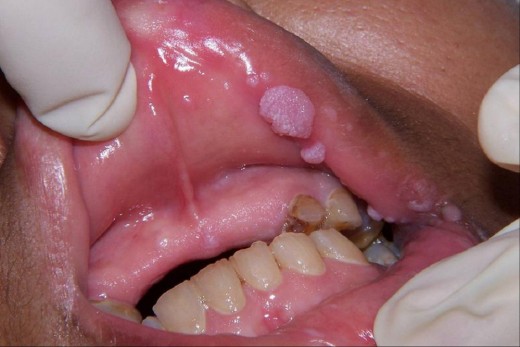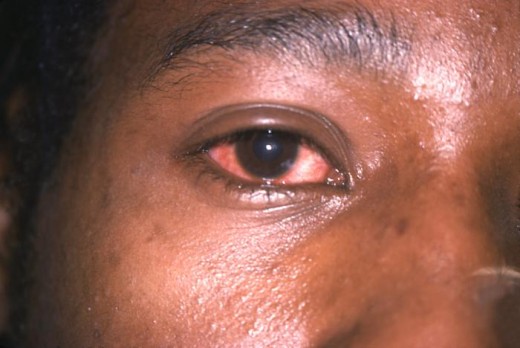Gonorrhea: Health Relevance, Pathology And Clinical Manifestations
Gonorrheal Outgrowths In Mucous Membranes

A General Overview Of Gonorrhea
Gonorrhea is one of the most common sexually transmitted diseases all over the world. This is caused by Neisseria gonorrhoeae, which is present throughout the world. Since several strains of N. gonorrhoeae have developed penicillin resistance due to the production of beta-lactamase, the disease increased in frequency and distribution. Due to altered sex practices, the manifestations have extended to several areas in the body.
Gonococci attach themselves to cells with the help of pilli before initiating infection. The organisms are ingested by polymorphs and they survive within the cells for variable periods, being protected from adverse environment. Four types can be distinguished by cultural characteristics, Types T1 and T2 are virulent whereas T3 and T4 are not.
Pathology: Gonococci affect columnar and transitional epithelium mainly and infection is initiated in the urethra, anal canal, conjunctiva, pharynx and endocervix. Pus is produced locally. Direct extension from the site of infection leads to complications such as endometritis, salpingitis, peritonitis and bartholinitis, in the female and periurethral abscess, epididymo-orchitis, and prostatitis in the male. Ocular conjunctiva is affected. Metastatic spread of the organisms leads to arthritis, dermatitis, endocarditis, meningitis, myopericarditis and hepatitis.
Gonorrheal Affection Of The Eye

Infectious Diseases
Clinical Presentations Of Gonorrhea
In the male, the onset of the disease is more smart and acute than in women. Incubation period is usually 3 to 5 days.
Gonorrhea in males: In over 90% of cases, urethritis presents with a constant burning sensation in the penis and discharge of infective pus which teems with the organisms. Meatal inflammation and penile edema may be obvious. Variable amounts of pus can be milked from the urethra. Micturition is painful and the patient is severely distress. Other adnexal structures like epidydimis, tests and spermatic cord become inflamed. Rarely, inflammation of the Tyson’s gland and the median raphe of the scrotum may develop. Gonococcal prostatitis and seminal vesiculitis are seen but they are rare. If left alone, the acute manifestations subside over a period of weeks or months even without treatment. Exacerbations occur frequently as a result of sexual indulgence, alcoholism or under exertion. Ultimately, the anterior and posterior urethra develop at times. Extension of suppuration into the periurethral tissues and scrotum result in fistulous openings discharging urine from multiple sites (“water-can scrotium”). In 10% of subjects, the lesion may be asymptomatic and has to be detected by examination.
The scrotum is an important site of ulceration in persons who are habitual catamites in homosexual relationship. The rectum and anal canal are ulcerated and show blood-stained mucopurulent discharge. The condition may present as proctitis and may be mistaken for other ulcerating lesions of this region.
Gonorrhea in the female: In a good number of women, gonerrhea may remain asymptomatic. Symptoms include leucorrhea, dysuria, pelvic inflammation. Rectal lesions develop in about 40% of affected women due to contamination by cervical discharges.
The gonococci may pass up from the endocervix leading to acute salpingitis and oophori-ovarian masses may develop. Exacerbations weeks thereafter. Gonococcal salpingo-oophoritis is a common cause of sterility.
Gonococcal Infection In the newborn:Inoculation of gonococci into the baby’s eyes from the maternal genital passages leads to ophthalmia neonatorium. This presents with purulent conjunctivitis which may result in blindness. The infection can also disseminate to other tissues and result in arthritis in the newborn.
Disseminated gonococcal infection: This occurs in up to 30% of infected patients. 80% of them being females. Bacteremic spread occurs. Manifestations include cutaneous lesions, septic arthritis, septicemia, endocarditis, myocarditis and rarely, pericarditis and meningitis. Risk of dissemination depends on the type and virulence of the organism. Dissemination is more common from silent foci in the pharynx, rectum, or endocervix. The cutanoeus lesions take the form of vesicles and pustules which do not usually ulcerate.
Oropharyngeal infections: Pharyngitis and tonsillitis result from oral sex and may affect both sexes. In the majority of cases, symptoms are not severe enough to seek medical care. Strong clinical suspicion and microbiological investigations are required to make the diagnosis. Gonococcal pharyngitis may give rise to dissemination.
© 2014 Funom Theophilus Makama









